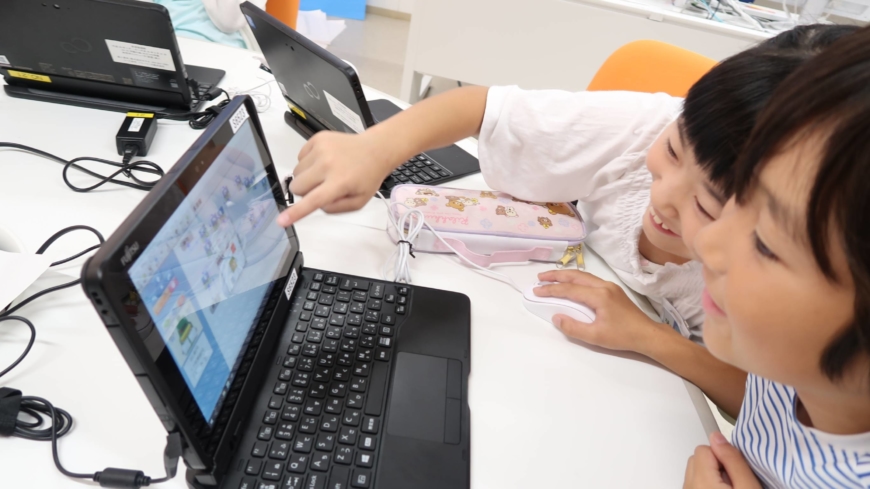[ad_1]
This is the third article in a Japan in Action series, showcasing key policies of the Suga administration.
Japan is moving forward by three years its ¥461 billion ($4.4 billion) plan to digitalize education among the country’s nearly 13 million primary and secondary school students and in its almost 35,000 schools.
The government initially hammered out the GIGA School Program in 2018 to ensure that they would have computers and high-speed internet, and educators would have the techniques to teach pupils how to master digital tools and learn online. GIGA stands for Global and Innovation Gateway for All.
That was part of a government push toward a post-information society called Society 5.0, incorporating cyberspace, such as artificial intelligence (AI), big data and the Internet of Things.
The Ministry of Education, Culture, Sports, Science and Technology originally targeted fully implementing the GIGA program by the end of March 2024. But the plan was front-loaded to the end of the current fiscal year, partly so schools could be better prepared should COVID-19 necessitate closures again.

“The GIGA program’s goal is to ensure that students in the Society 5.0 era, where information and communication technology (ICT) is a part of daily lives and absolutely necessary, will learn the needed skills and abilities to thrive,†said Yuichi Imai, director of the Media, Information and Foreign Language Education Division in the education ministry’s Elementary and Secondary Education Bureau. “We want to ensure that nobody is left behind and that opportunities are equitable, tailored to individual needs and enable creativity.â€
Only 15 percent of classes were online at the end of June 2020, he noted, adding that the government is working to increase that.
‘1 device for 1 student’
Even before COVID-19, alarms sounded over Japan’s digital education levels. Students were adroit at using the internet and devices for communicating, playing games and watching videos, but they weren’t that adept at using them to find, synthesize and apply online information.
One factor behind that was the dearth of PCs for students in school education caused by tight local government budgets. It will be resolved by providing computers for all students in compulsory education by the start of the upcoming fiscal year in April, Imai said. About two-thirds of the GIGA plan’s budget is allocated for PCs.
To prepare educators, the ministry is cooperating with the private sector to provide support and advice to local governments and schools that are developing digital learning environments. For example, the ministry has created an ICT advisory board, comprised of professionals in this area, to give lectures and consultation to better utilize ICT at schools and improve the level of education. The ministry also wants to develop online courses for current practitioners, as well, Imai said.
With such support, Imai said educators will be able to teach students how to conduct online searches and use software for writing and putting together presentations. And teachers will be able to conduct computer-based testing — which should help reduce their heavy workload — and use learning-management systems to more efficiently assess the progress of pupils.

At the forefront
Even ahead of the recent government moves, some municipalities had already taken the digital plunge.
Among them, Toda in Saitama Prefecture stands out for its early action. The city’s policies, similar to the GIGA program, involve distributing PCs to all students (starting from 2016), ensuring internet access, including providing mobile routers to households without net access, and training teachers.
“Digitalization wasn’t pursued before because of tight budgets — and because blackboards, chalk and handouts had been successful, as seen in international test scores. ‘Why mess with it?’ was the view,†said Yuki Fusegawa, an official at the Toda Board of Education. “We realized, however, to be able to raise children well equipped to deal with Society 5.0 and an age when AI is at the forefront that ICT skills were absolutely necessary.â€
For example, in Toda’s Project-Based Learning program, students use PCs to research topics on their own, find a solution to a problem and introduce their findings in a presentation, such as one where students come up with an idea to make school backpacks lighter.
Using IT has also enabled students to communicate more easily with each other, namely by working on group projects and brainstorming. In this way, they can spend more time on discussions and improving their projects.
Another effect can be seen in the fact that the digital tools would help shy students express and deliver their ideas without having to raise their hands and speak in front of teachers and classmates. At the same time, physically challenged students, such as the hearing-impaired, are able to readily participate if they can see discussions taking place on a screen.
Additionally, AI-infused lesson drills are helping pupils with subjects that they are having problems understanding by tailoring lessons to them. “We’re still assessing the impact, but teachers say that students that hadn’t finished their homework before are getting it done now,†Fusegawa said, referring to the positive impact on students, which has increased their motivation to study.
With such frontrunners like Toda, Imai said the government will be able to more effectively implement the GIGA program nationwide. “At the ground level,†he said, “some strong examples already are being put into practice.â€
This series is sponsored by the government of Japan.

Â
[ad_2]
Source link





